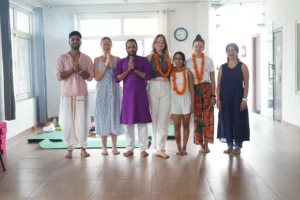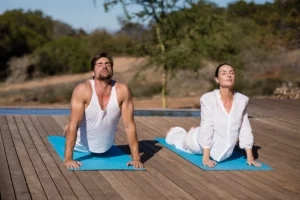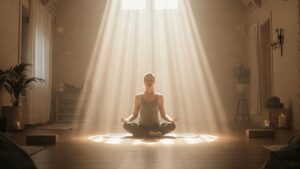Let’s explore Vinyasa yoga, a globally popular and dynamic style known for its flowing sequences and emphasis on breath. This approach offers a refreshing and energizing experience, but what exactly is Vinyasa, and how does it differ from styles like Ashtanga Vinyasa? Let’s delve into the essence of Vinyasa flow, its unique benefits, and the history behind this transformative practice.
What is Vinyasa Yoga?
Vinyasa yoga centers around connecting breath with movement. The Sanskrit term “Vinyasa” means “arranging in a special way,” highlighting the practice’s focus on creating a flowing sequence of seamlessly transitioning postures. Each movement is synchronized with the breath, making the practice both physical and mindful.
Often called “flow yoga,” Vinyasa is sometimes confused with “power yoga,” which emphasizes intense physicality. However, Vinyasa is more than just a workout; it’s about harmonizing breath and body to promote balance, flexibility, strength, and mental clarity.
The Essence of Vinyasa Flow
Fluidity is the hallmark of Vinyasa flow. Unlike more rigid styles like Bikram (with its fixed 26 postures) or Ashtanga Vinyasa (with its set sequences), Vinyasa classes are rarely identical. The varied postures and sequences allow for constant evolution and adaptation.
This variability fosters a balanced physique and reduces the risk of repetitive motion injuries. The unpredictable nature of Vinyasa also encourages creativity and keeps the practice engaging.
Philosophically, Vinyasa reflects the concept of impermanence: like life itself, postures are entered, held briefly, and then released—a series of transitions.
The Historical Roots of Vinyasa
While the concept of Vinyasa dates back thousands of years to the Vedic period (where it referred to sacred steps or sequences), the modern practice is largely attributed to T. Krishnamacharya, a highly influential figure in modern yoga. His teachings established Vinyasa as we know it: breath-initiated movements that guide us towards a more intentional and connected way of living.
Vinyasa isn’t solely about physical postures; it’s about navigating life with purpose and mindfulness, always aware of the flow of breath and movement. It connects the external and internal, helping practitioners move towards what they hold sacred.
Defining Vinyasa Yoga
“Vinyasa” has multiple layers of meaning. According to Srivatsa Ramaswami, a long-time student of Krishnamacharya, it combines “vi” (variation) and “nyasa” (to place), referring to the intentional arrangement of movements. Each action is deliberate and conscious.
Vinyasa isn’t about haphazard movement; it’s about bringing full awareness to each action. As yoga teacher Shiva Rea explains, Vinyasa’s origins in early Tantras define it as the “sequence of consciousness,” reflecting how life unfolds through creative expression, with each movement mirroring our inner state.
Vinyasa is the practice of connecting movement to breath in a continuous, rhythmic way, where every action expresses the present moment. It’s about flow, connection, rhythm, and evolution. Synonyms include seamless, integrated, evolving, and cyclical.
Characteristics of Vinyasa Flow Yoga
A defining characteristic of Vinyasa flow is its focus on transitions—the moments connecting one posture to the next. These transitions are as important as the postures themselves, and the fluidity of movement creates a graceful and dynamic practice.
Unlike alignment-focused practices that emphasize holding postures for extended periods, Vinyasa flows through postures, prioritizing breath. The breath acts as the “glue” linking movements, creating “breath-synchronized movement.”
The Ujjayi breath, commonly used in Vinyasa, involves rhythmic inhalations and exhalations through the nose, creating a calming effect that enhances concentration and promotes relaxation even during challenging sequences.
Vinyasa classes can be physically intense, and the flow of postures generates heat, adding a cardiovascular element. Many find this combination of breath and movement energizing and revitalizing.
ConclusionThe Benefits of Vinyasa Yoga
Vinyasa offers numerous physical and mental benefits:
- Improved Flexibility and Strength: Dynamic movement and holding poses increase flexibility while building strength, especially in the core, arms, and legs.
- Cardiovascular Health: The continuous flow elevates heart rate, providing an aerobic workout that improves cardiovascular health and stamina.
- Mental Clarity and Stress Relief: The breath-centered focus calms the mind, reducing stress and anxiety by promoting present-moment awareness.
- Detoxification: The rhythmic movements and generated heat stimulate circulation, promote lymphatic drainage, and support detoxification.
- Balance and Coordination: Balancing poses and transitions enhance coordination and balance, improving posture and stability.
- Increased Energy: The focus on breath and movement awakens the body’s energy, boosting mood and vitality.
- Mind-Body Connection: Vinyasa fosters a deep mind-body connection, increasing awareness and leading to more intentional actions.
Conclusion
Vinyasa yoga is a powerful, dynamic practice that offers more than just a physical workout. Whether practicing a Vinyasa flow or a structured Ashtanga sequence, its beauty lies in its fluidity, breath-initiated movement, and focus on the present moment. The variety of postures and focus on transitions ensures a constantly engaging practice.
With benefits ranging from increased flexibility and strength to improved mental clarity and stress relief, Vinyasa offers a holistic approach to health and wellness. Whether beginner or seasoned practitioner, Vinyasa offers a transformative journey towards balance, peace, and personal growth. Sources and related content








